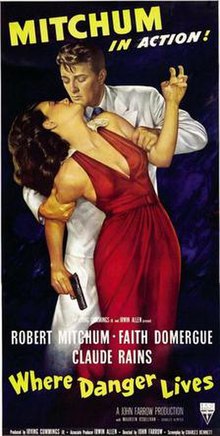
Crossfire is a 1947 American film noir drama film starring Robert Young, Robert Mitchum and Robert Ryan which deals with the theme of anti-Semitism, as did that year's Academy Award for Best Picture winner, Gentleman's Agreement. The film was directed by Edward Dmytryk and the screenplay was written by John Paxton, based on the 1945 novel The Brick Foxhole by screenwriter and director Richard Brooks. The film's supporting cast features Gloria Grahame and Sam Levene. The picture received five Oscar nominations, including Ryan for Best Supporting Actor and Gloria Grahame for Best Supporting Actress. It was the first B movie to receive a Best Picture nomination.
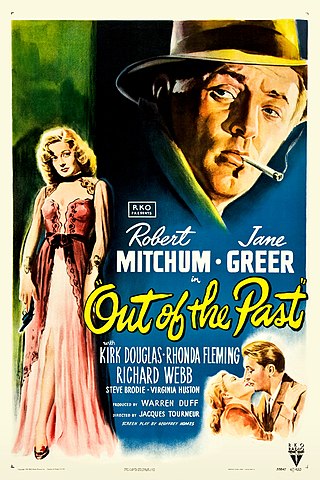
Out of the Past is a 1947 American film noir directed by Jacques Tourneur and starring Robert Mitchum, Jane Greer, and Kirk Douglas. The film was adapted by Daniel Mainwaring from his 1946 novel Build My Gallows High, with uncredited revisions by Frank Fenton and James M. Cain.

Robert Charles Durman Mitchum was an American actor. He is known for his antihero roles and film noir appearances. He received nominations for an Academy Award and a BAFTA Award. He received a star on the Hollywood Walk of Fame in 1984 and the Golden Globe Cecil B. DeMille Award in 1992. Mitchum is rated number 23 on the American Film Institute's list of the greatest male stars of classic American cinema.
The Beat Generation is a 1959 American crime film noir from Metro-Goldwyn-Mayer starring Steve Cochran and Mamie Van Doren, with Ray Danton, Fay Spain, Maggie Hayes, Jackie Coogan, Louis Armstrong, James Mitchum, Vampira, and Ray Anthony. It is a sensationalistic interpretation of the beatnik counterculture of the "Beat Generation" The movie was also shown under the title This Rebel Age. The movie is about a "beatnik" who is a serial rapist, who is pursued by a police detective. The director was Charles F. Haas. Richard Matheson and Lewis Meltzer are credited with the screenplay.

On Dangerous Ground is a 1951 film noir directed by Nicholas Ray, starring Robert Ryan and Ida Lupino, and produced by John Houseman. The screenplay was written by A. I. Bezzerides based on the 1945 novel Mad with Much Heart by Gerald Butler.

The Narrow Margin is a 1952 American film noir starring Charles McGraw and Marie Windsor. Directed by Richard Fleischer, the RKO picture was written by Earl Felton, based on an unpublished story written by Martin Goldsmith and Jack Leonard. The screenplay by Earl Felton was nominated for an Academy Award.

Fear in the Night is an American 1947 film noir crime film directed by Maxwell Shane, starring Paul Kelly and DeForest Kelley. It is based on the Cornell Woolrich story "And So to Death". Woolrich is credited under pen name William Irish. The film was remade by the same director in 1956 with the title Nightmare this time starring Edward G. Robinson playing the cop and Kevin McCarthy.

The Big Clock is a 1948 American thriller directed by John Farrow and adapted by novelist-screenwriter Jonathan Latimer from the 1946 novel of the same title by Kenneth Fearing.

Macao is a 1952 American adventure film noir directed by Josef von Sternberg and Nicholas Ray and starring Robert Mitchum, Jane Russell, William Bendix, and Gloria Grahame. Shot in black-and-white, it was distributed by RKO Pictures.
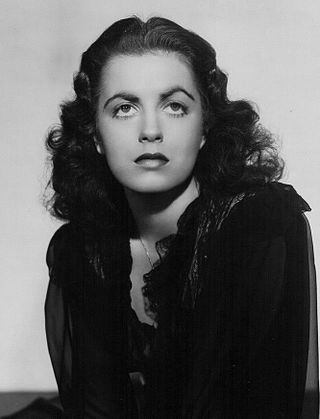
Faith Marie Domergue was an American film and television actress. Discovered at age 16 by media and aircraft mogul Howard Hughes, she was signed to a contract with Hughes's RKO Radio Pictures and cast as the lead in the studio's thriller Vendetta, which had a troubled four-year production before finally being released in 1950.

Street of Chance is a 1942 American film noir mystery film directed by Jack Hively and starring Burgess Meredith as a man who finds he has been suffering from amnesia and Claire Trevor as a woman who protects him from the police, who suspect him of murder. He is suspected of the murder of the wealthy Harry Diedrich. The only eyewitness to the murder was Harry's mute grandmother, and she can only communicate with others through sign language.
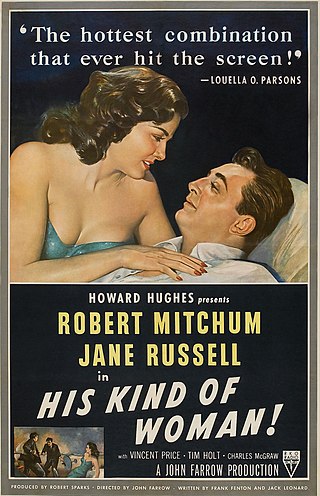
His Kind of Woman is a 1951 film noir starring Robert Mitchum and Jane Russell. The film features supporting performances by Vincent Price, Raymond Burr and Charles McGraw. The direction of the film, which was based on the unpublished story "Star Sapphire" by Gerald Drayson, is credited to John Farrow.
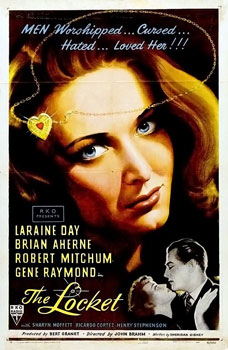
The Locket is a 1946 American psychological thriller film noir directed by John Brahm, starring Laraine Day, Brian Aherne, Robert Mitchum, and Gene Raymond, and released by RKO Pictures. The film is based on a screenplay by Sheridan Gibney, adapted from "What Nancy Wanted" by Norma Barzman, wife of later-blacklisted writer Ben Barzman. It is noted for its complex and confusing use of layered flashbacks within flashbacks to give psychological depth to the narrative.

Framed is a 1947 American crime film noir directed by Richard Wallace and starring Glenn Ford, Janis Carter and Barry Sullivan. It was released by Columbia Pictures. The movie is generally praised by critics as an effective crime thriller despite its low budget.

Pushover is a 1954 American film noir crime film directed by Richard Quine, starring Fred MacMurray, Phil Carey and Kim Novak in her first credited role. The motion picture was adapted from two novels, Thomas Walsh's The Night Watch and William S. Ballinger's Rafferty, by Roy Huggins, who went on to great success creating television series, including The Fugitive, Maverick, and The Rockford Files.
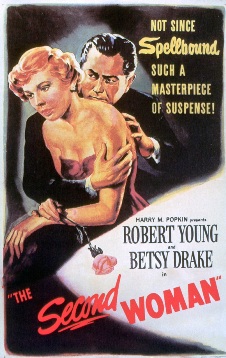
The Second Woman is a 1950 American film noir mystery-suspense film directed by James V. Kern and featuring Robert Young, Betsy Drake, John Sutton and Florence Bates. Sequences of the film were shot on the coastal areas of Monterey, California.
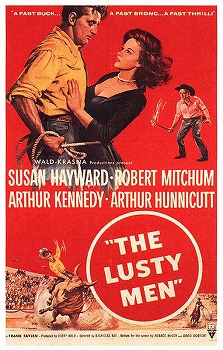
The Lusty Men is a 1952 neo-Western film released by Wald-Krasna Productions and RKO Radio Pictures starring Susan Hayward, Robert Mitchum, Arthur Kennedy and Arthur Hunnicutt. The picture was directed by Nicholas Ray and produced by Jerry Wald and Norman Krasna from a screenplay by David Dortort and Horace McCoy, with uncredited contributions by Alfred Hayes, Andrew Solt, and Wald, that was based on the novel by Claude Stanush. The music score was by Roy Webb and the cinematography by Lee Garmes.
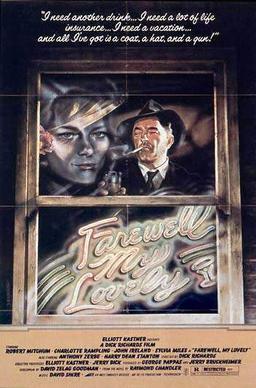
Farewell, My Lovely is a 1975 American neo-noir crime thriller film directed by Dick Richards and featuring Robert Mitchum as private detective Philip Marlowe. The picture is based on Raymond Chandler's novel Farewell, My Lovely (1940), which had previously been adapted for film as Murder, My Sweet in 1944. The supporting cast features Charlotte Rampling, John Ireland, Jack O'Halloran, Sylvia Miles, Harry Dean Stanton and hardcore crime novelist Jim Thompson, in his only acting role, as Charlotte Rampling's character's elderly husband Judge Grayle. Mitchum returned to the role of Marlowe three years later in the 1978 film The Big Sleep, making him the only actor to portray the character more than once in a feature film.
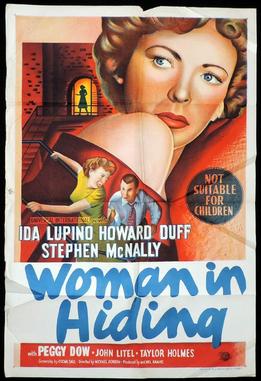
Woman in Hiding is a 1950 American melodrama starring Ida Lupino, Howard Duff and Stephen McNally. It was directed by Michael Gordon, with cinematography by William H. Daniels. Peggy Dow, John Litel, and Taylor Holmes, appear in support. Some observers regard the picture as a film noir, a view not universally embraced.

Mysterious Intruder is a 1946 American mystery film noir based on the radio drama The Whistler. Directed by William Castle, the production features Richard Dix, Barton MacLane and Nina Vale. It is the fifth of Columbia Pictures' eight "Whistler" films produced in the 1940s, the first seven starring Dix.
